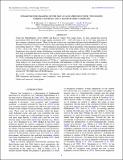Subarcsecond imaging of the NGC 6334 I(n) protocluster : two dozen compact sources and a massive disk candidate
Abstract
Using the Submillimeter Array (SMA) and Karl G. Jansky Very Large Array, we have imaged the massive protocluster NGC 6334 I(N) at high angular resolution (0″5 ~ 650 AU) from 6 cm to 0.87 mm, detecting 18 new compact continuum sources. Three of the new sources are coincident with previously identified H2O masers. Together with the previously known sources, these data bring the number of likely protocluster members to 25 for a protostellar density of ~700 pc–3. Our preliminary measurement of the Q-parameter of the minimum spanning tree is 0.82—close to the value for a uniform volume distribution. All of the (nine) sources with detections at multiple frequencies have spectral energy distributions consistent with dust emission, and two (SMA 1b and SMA 4) also have long wavelength emission consistent with a central hypercompact H II region. Thermal spectral line emission, including CH3CN, is detected in six sources: LTE model fitting of CH3CN (J = 12-11) yields temperatures of 72-373 K, confirming the presence of multiple hot cores. The fitted LSR velocities range from –3.3 to –7.0 km s–1, with an unbiased mean square deviation of 2.05 km s–1, implying a protocluster dynamical mass of 410 ± 260 M☉. From analysis of a wide range of hot core molecules, the kinematics of SMA 1b are consistent with a rotating, infalling Keplerian disk of diameter 800 AU and enclosed mass of 10-30 M☉ that is perpendicular (within 1°) to the large-scale bipolar outflow axis. A companion to SMA 1b at a projected separation of 0″45 (590 AU; SMA 1d), which shows no evidence of spectral line emission, is also confirmed. Finally, we detect one 218.4400 GHz and several 229.7588 GHz Class-I CH3OH masers.
Citation
Hunter , T R , Brogan , C L , Cyganowski , C J & Young , K H 2014 , ' Subarcsecond imaging of the NGC 6334 I(n) protocluster : two dozen compact sources and a massive disk candidate ' , Astrophysical Journal , vol. 788 , no. 2 , 187 . https://doi.org/10.1088/0004-637X/788/2/187
Publication
Astrophysical Journal
Status
Peer reviewed
ISSN
0004-637XType
Journal article
Collections
Items in the St Andrews Research Repository are protected by copyright, with all rights reserved, unless otherwise indicated.

